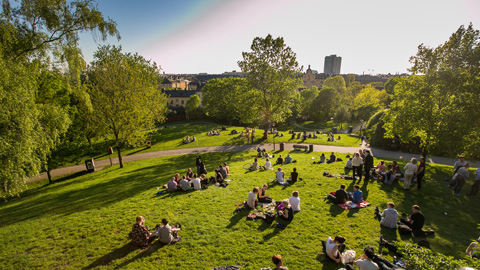Urban green spaces not beneficial to all, says ICTA-UAB study

04/04/2019
The creation of parks and green spaces within urban areas in general have positive effects on residents. However, when explored more in depth, researchers conclude that only the more affluent social classes benefit from these spaces. A new article published by the research group from the Institute for Environmental Science and Technology at the Universitat Autònoma de Barcelona (ICTA-UAB) and the Institute for Medical Research at the Hospital del Mar (IMIM) reveals that, although living in areas with green spaces is associated with better health levels when self-rated by residents, these benefits do not reach social classes with lower income and education levels.
The progressive "ecologisation" of cities due to the creation of green spaces, parks and walkways can have positive benefits on the physical and psychological health of individuals. This growing "greenification" process has been associated with better air quality, an increase in exercising and the creation of stronger social ties among neighbours, thus reducing chronic stress levels and improving health in general. Nevertheless, these transformations can be accompanied by gentrification processes in which the original population of a lower-middle and low class neighbourhood is displaced (socially, culturally and/or physically) by new more affluent residents attracted to the area for its housing offer or services.
The study, conducted in New York City and published in Health & Place, for the first time assessed whether a gentrification process experienced in certain neighbourhoods modifies the already existent relation between green spaces and health. Researchers collected demographic information and self-rated health data of over 44,000 NYC residents in three types of neighbourhoods: non-gentrified neighbourhoods (which already included many affluent residents), neighbourhoods undergoing gentrification and neighbourhoods which were not being gentrified.
The results show that the amount of green spaces only produces positive effects on the health of residents in neighbourhoods being gentrified. However, within this type of neighbourhood, only the more affluent residents, i.e. higher income and education (university graduates minimum) levels, seem to benefit from these green spaces. Therefore, more vulnerable groups, with lower income and education levels, do not benefit from these greener neighbourhoods.
"Gentrification modifies the effect being in green spaces has on health, with benefits only for a few privileged citizens", affirms Dr Helen Cole, first author and member of the Barcelona Lab for Urban Environmental Justice and Sustainability (BCNUEJ) at ICTA-UAB. She declares that greener cities are not always fairer and equally healthy for all, and that the benefits of green spaces are not the same for everyone.
The amount of green spaces in the other two types of neighbourhoods (not undergoing gentrification) is not related to any health benefits for residents. This may be due to the fact that the effect green spaces have does not counterbalance other determining health factors. For example, residents in affluent neighbourhoods can enjoy many other services and activities which benefit their health. In contrast, more vulnerable social classes generally present worse health conditions due to their socio-economic conditions and other disadvantages.
Dr Helen Cole emphasises the importance of these results because "a common argument in favour of gentrification is that the 'benefits' from new improved spaces, such as those in gentrified neighbourhoods, positively affect residents in the long term. Our results point to the fact that health benefits due to green spaces do not seem to exist", and she goes on to say that "only those we considered the 'gentrifiers' benefit from these improvements, while residents with lower income and education levels do not benefit from neighbourhoods being gentrified". Therefore, the authors of the study highlight that structural interventions, such as new green spaces, must be planned and assessed within an equitable context of urban social change, and actions need to be coordinated with other sectors and priorities such as health and housing.
Original article:
Cole H.V.S., Triguero-Mas M., Connolly J.J.T, Anguelovski I. (2019). Determining the health benefits of green space: Does gentrification matter? Health & Place, 57 1-11
Available online at: https://doi.org/10.1016/j.healthplace.2019.02.001